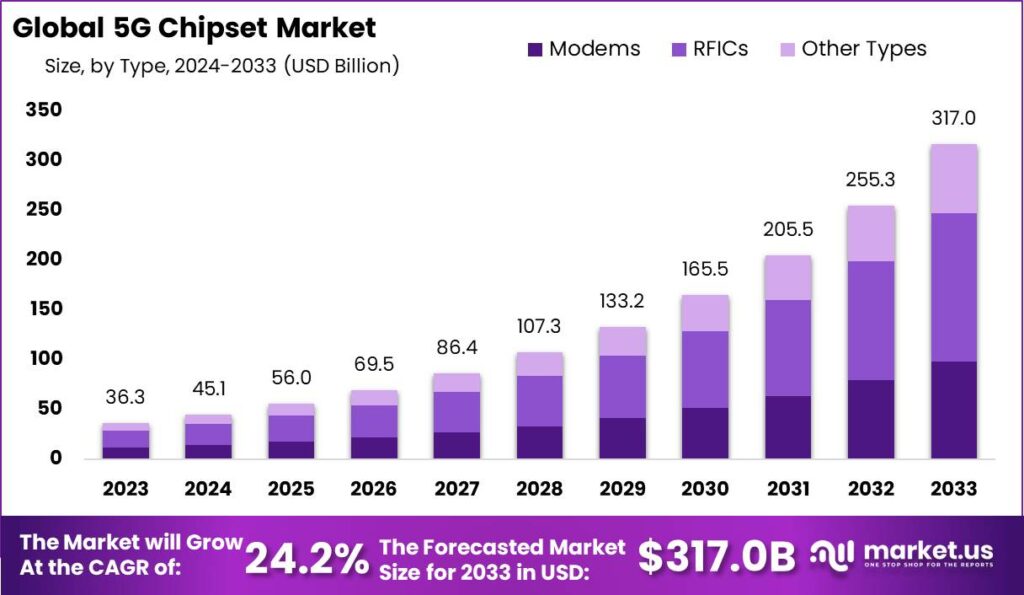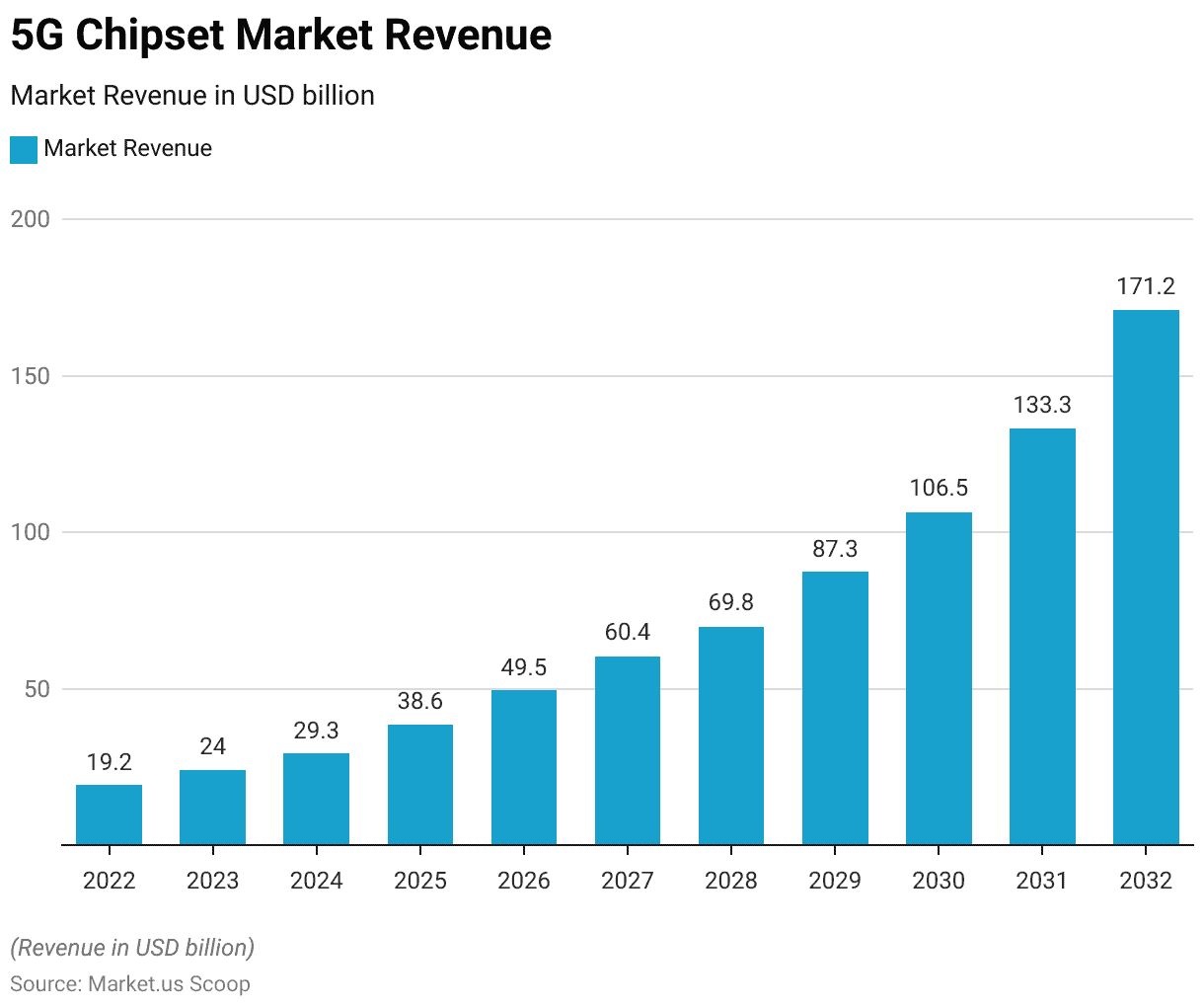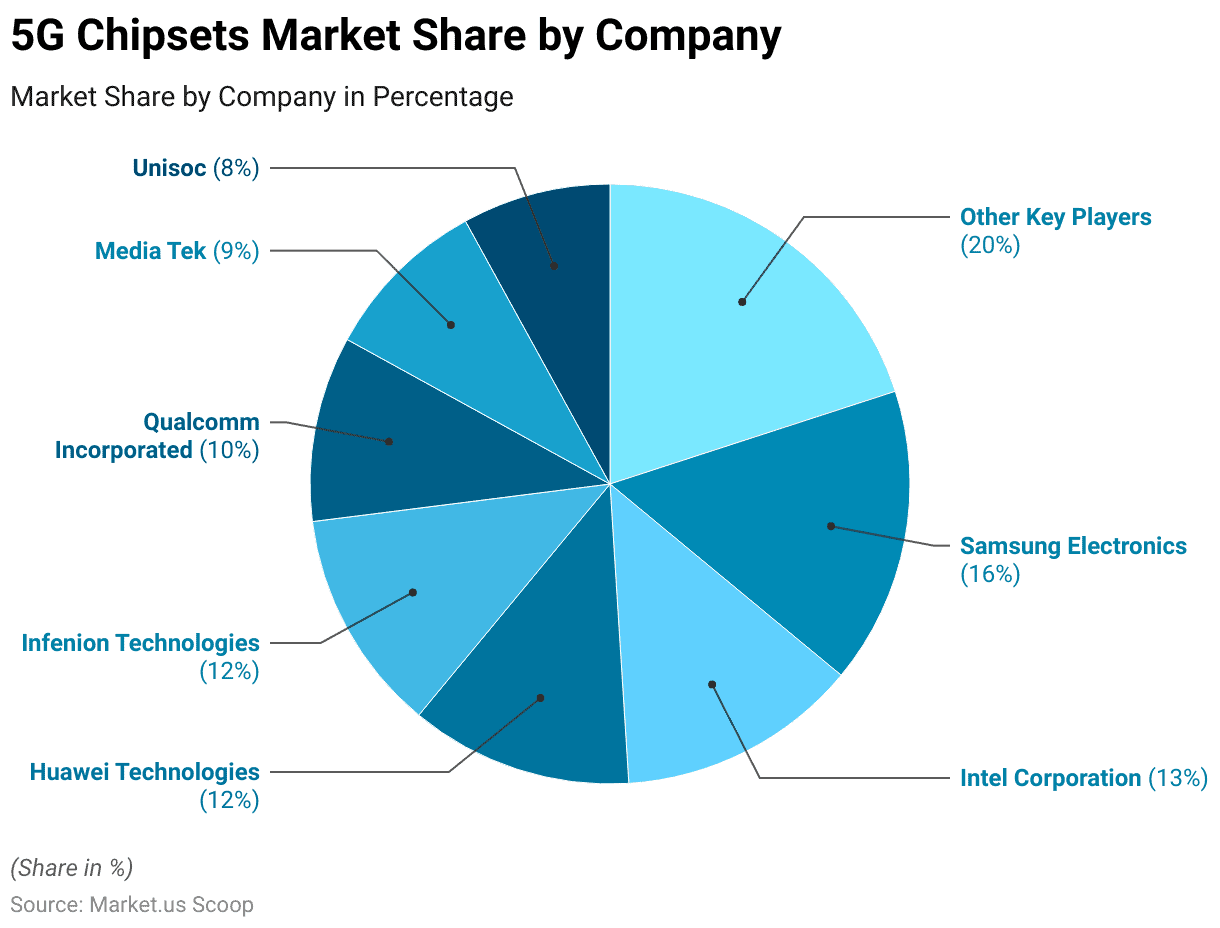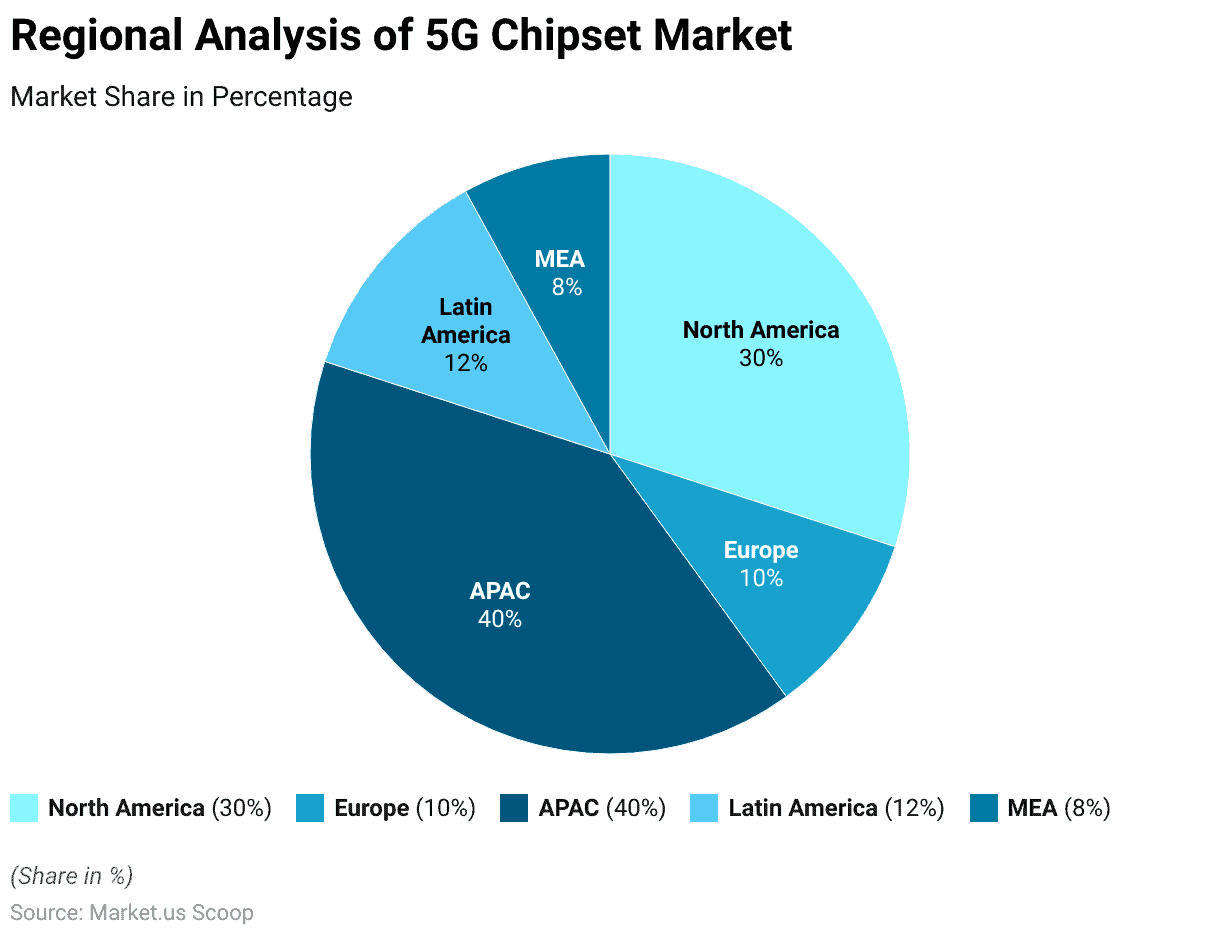Table of Contents
- Introduction
- Editor’s Choice
- Global 5G Chipset Market Statistics
- Key Players in the 5G Chipset Market Statistics
- Regional Analysis of 5G Chipset Market Statistics
- Types of 5G Chipset Statistics
- 5G Chipset Key Features and Specifications Statistics
- 5g Chipset Energy Efficiency Statistics
- Government Regulations Related to 5G Chipset Technology Statistics
- Recent Developments
- Conclusion
- FAQs
Introduction
5G Chipset Statistics: 5G chipsets play a vital role in 5G networks, serving as the central processing units for communication.
These chipsets consist of essential components like modems, baseband processors, and RF front-ends. Allowing them to handle high data speeds, minimize delays, and work with different frequency bands, including sub-6 GHz and millimeter-wave.
They’re used in smartphones, IoT devices, automotive tech, and industries, powering features like fast internet, responsive gaming, and autonomous driving.
Major semiconductor companies like Qualcomm, MediaTek, Intel, and Samsung lead the way in producing these chipsets.
Challenges include effectively managing heat, signal processing, and network compatibility complexities. Looking ahead, we anticipate 6G development, closer integration with AI, and a growing range of applications across various industries.

Editor’s Choice
- The revenue generated by the 5G chipset market is poised for significant growth in the coming years at a CAGR of 24.67%.
- In 2022, the 5G chipset market recorded a revenue of USD 19.2 billion. Projected to steadily rise in the subsequent years.
- Samsung Electronics CO., Ltd. stands out as a frontrunner, commanding a substantial 16% market share.
- North America holds the largest market share, with 30.0%. Driven by the rapid deployment of 5G networks and strong consumer demand for high-speed connectivity.
- The MediaTek Helio M70 is a versatile chipset that supports 2G, 3G, 4G, and 5G networks, covering many connectivity options.
- There are three key ISM bands for RF and wireless chips: 902 – 928 MHz, 2.400 – 2.500 GHz, and 5.725 – 5.875 GHz.
- 5G chipsets bring substantially faster data speeds than 4G, boasting peak rates of up to 20 gigabits per second (Gbps).

Global 5G Chipset Market Statistics
5G Chipset Market Size Statistics
- The revenue generated by the 5G chipset market is poised for significant growth in the coming years at a CAGR of 24.67%.
- In 2022, the market recorded a revenue of USD 19.2 billion, projected to rise in the subsequent years steadily.
- By 2023, the market is expected to reach USD 24.0 billion, marking a notable increase.
- The growth trajectory continues as we move forward. With revenues forecasted to reach USD 29.3 billion in 2024 and USD 38.6 billion in 2025.
- As the demand for 5G technology continues to surge, the market is set to see substantial gains. With revenue estimates of USD 49.5 billion in 2026, USD 60.4 billion in 2027, and USD 69.8 billion in 2028.
- The trend continues with even more remarkable numbers. Reaching USD 87.3 billion in 2029, USD 106.5 billion in 2030, and USD 133.3 billion in 2031.
- By 2032, the 5G chipset market is projected to hit a remarkable revenue milestone of USD 171.2 billion.
- This data reflects the ever-expanding influence of 5G technology in various industries, indicating a promising future for the market.
(Source: Market.us)

Key Players in the 5G Chipset Market Statistics
- Several key players have emerged in the highly competitive 5G chipset market. Each vying for a significant share of this rapidly evolving industry.
- Samsung Electronics CO., Ltd. stands out as a frontrunner, commanding a substantial 16% market share.
- Qualcomm Incorporated follows closely behind with a 10% share, known for its pioneering work in wireless technologies.
- Huawei Technologies Co., Ltd. and Infineon Technologies AG share 12% each, emphasizing their global presence and innovative contributions.
- Intel Corporation is also a prominent player with a 13% share, leveraging its expertise in semiconductor technology.
- MediaTek Inc. and Unisoc Communications, Inc. secure 9% and 8%, respectively, showcasing their role in providing 5G solutions.
- Additionally, various other key players collectively account for 20% of the market. Demonstrating the diversity and competitiveness within the 5G chipset sector.
- These companies are continuously pushing boundaries to lead the way in enabling the next generation of wireless communication.
(Source: Market.us)
Take advantage of our unbeatable offer - buy now!


Regional Analysis of 5G Chipset Market Statistics
- The global 5G chipset market is experiencing varying growth across different regions.
- North America holds the largest market share, with 30.0%. Driven by the rapid deployment of 5G networks and strong consumer demand for high-speed connectivity.
- In Europe, the market share stands at 10.0%, reflecting a somewhat slower adoption rate than in North America.
- Meanwhile, the Asia-Pacific (APAC) region dominates the market with a substantial 40.0% market share. Driven by the sheer size of the population, increasing smartphone penetration, and a strong focus on technological advancements.
- Latin America accounts for 12.0% of the market share, showing potential for growth as 5G infrastructure continues to expand.
- Finally, the Middle East and Africa (MEA) region holds 8.0% of the market share. Indicating a growing interest in 5G technology in these regions.
- The 5G chipset market is dynamic and evolving, with each region contributing differently to its global landscape.

Types of 5G Chipset Statistics
Baseband chipsets
- The 5G baseband chip plays a critical role in managing smartphone networks, and the chip’s quality significantly impacts the strength of mobile signals.
- In essence, the baseband chip is the lifeline enabling smartphone communication. Without this chip, the phone would not connect with the outside world.
- Unisoc’s Full-Netcom single-chip is a versatile solution that provides extensive network support, making it a valuable component in telecommunications.
- This single chip offers compatibility with a wide range of network standards, including TDD NR, FDD NR, FDD-LTE, TDD-LTE, TD-SCDMA, WCDMA, and GSM, ensuring seamless connectivity across various network types.
- It also boasts broad frequency band support, covering global mainstream bands such as Sub-6GHz, including n78, n41, n79, n1, n28, n77, n3, n8, n20, and more.
- Furthermore, it incorporates advanced technologies like VoNR (Voice over New Radio) and VoLTE (Voice over LTE) in 5G Standalone (SA) mode, enhancing the quality and capabilities of voice communication over 5G networks.
- The MediaTek Helio M70 is a versatile chipset that supports 2G, 3G, 4G, and 5G networks, covering many connectivity options.
- It embraces 5G technology, including both standalone (SA) and non-standalone (NSA) network architectures, and sub-6GHz frequency bands. High power user equipment (HPUE), and other key 5G features in line with 3GPP Rel-15 specifications.
- With a remarkable 5 Gbps data rate, it leads the industry in supporting carrier aggregation.
- The chipset enhances user experiences by enabling LTE and 5G dual connectivity (EN-DC). While ensuring backward compatibility with 4G, 3G, and 2G networks when 5G is unavailable.
(Source: Unisoc, MediaTek)
RF (Radio Frequency) Chipsets
- A 5G RF (Radio Frequency) chipset refers to the components and integrated circuits responsible for handling the radio frequency signals in 5G communication. These chipsets are a crucial part of 5G devices and are significant in ensuring reliable and high-performance wireless communication in 5G networks.
- RF and wireless chip specifications cover supply voltage, data rate, sensitivity, power usage, and operating temperature.
- Other crucial factors include the Industry, Science, and Medicine (ISM) bands and integrated circuit (IC) packaging type.
- There are three key ISM bands for RF and wireless chips: 902 – 928 MHz, 2.400 – 2.500 GHz, and 5.725 – 5.875 GHz.
- Various IC packaging options exist, such as ball-grid array (BGA), flip-chip ball-grid array (FCBGA), plastic ball-grid arr anday (PBGA), multi-chip module plastic ball-grid array (MCM-PBGA), super ball-grid array (SBGA), tape ball-grid array (TBGA), pin-grid array (PGA), ceramic pin-grid array (CPGA), plastic pin-grid array (PPGA), and flip-chip pin-grid array (FCPGA).
- Dallas-based Texas Instruments offers three RF chipsets: TRF11xx (2.5 GHz), TRF12xx (3.5 GHz), and TRF24xx (5.8 GHz). These chipsets support the IEEE 802.16d/e standard RF front end, serving wireless base stations, access points, equipment backhaul, point-to-point microwave, and public safety band uses.
- They are versatile and compatible with emerging IEEE 802.16-based WiMAX and WiBro applications and conventional fixed wireless access solutions.
- The Snapdragon X75 5G Modem-RF System is engineered with a forward-thinking approach, intended to be at the forefront of advanced 5G technology for mobile devices and beyond.
- It incorporates the Qualcomm 5G AI Processor Gen 2, marking it as the world’s inaugural Modem-RF System to include a specialized AI tensor accelerator.
- With a 2.5-fold enhancement in AI performance compared to its predecessor, the Snapdragon X75 is oriented towards providing outstanding 5G capabilities and precise GNSS location accuracy through AI-based processes.
(Source: Global Spec, EE Times, Qualcomm)
Modem Chipsets
- 5G modem chipsets are a specialized category designed to enable high-speed, low-latency connectivity to 5G networks.
- Hi-Silicon, a division of Huawei, has two generations of cellular modems in its lineup.
- The first-generation Balong 5G01 modem is exclusively designed for 5G connectivity. While the second-generation Balong 5000 modems offer support for both LTE and 5G networks.
- They also offer a 5G version of their Kirin processor, the Kirin 990.
- Mediatek boasts the Helio M70 modem and a versatile multi-mode 5G system-on-chip that includes the M70 modem.
- Qualcomm brings the Snapdragon 855 and 855+ mobile platforms, complemented by the Snapdragon X50 and X55 modems.
- Samsung introduced the Exynos 5100 (S5T5100) modem and recently revealed the Exynos 980 mobile processor and the complementary Exynos 5123 modem.
- UNISOC, previously known as Spreadtrum, has gained attention for its IVY510 5G modem chipset, also occasionally referred to as IVYO510.
- U-Blox offers a chipset with 5G upgrade capabilities, specifically the UBX-R5 IoT chipset, which can eventually support 5G through a software update delivered over the air (OTA).
(Source: GSA)
5G Chipset Key Features and Specifications Statistics
Frequency Bands
- According to 3GPP standards, the first frequency range spans from 410 MHz to 7125 MHz, commonly called the sub-7 GHz or sub-6 GHz spectrum.
- This range is employed for WLAN and LTE/LTE-Advanced technologies and generally lacks major RF complications.
- However, it suffers from congestion due to extensive usage.
- The other band encompasses approximately 30 to 100 GHz, with 3GPP delineating it between 24250 MHz and 52600 MHz, known as the (mmWave) or millimeter band.
- This band boasts ample bandwidth for large-capacity, high-speed data transmission, primarily because it is underutilized.
- Nevertheless, it grapples with challenges such as notable signal attenuation over-the-air (OTA) and unresolved technical issues arising from limited previous adoption by mobile operators.
(Source: Amritsu)
Data Rates
- 5G chipsets bring substantially faster data speeds than 4G, boasting peak rates of up to 20 gigabits per second (Gbps).
- In the U.S., T-Mobile recorded an average 5G download speed of 186.3 Mbit/s, while South Korea leads globally with an average speed of 432 megabits per second (Mbps).
- Additionally, 5G networks are engineered to provide much greater capacity than 4G, with an anticipated 100-fold increase in network efficiency.
- The prevalent form of 5G, known as sub-6 GHz 5G or mid-band, can deliver data rates ranging from 10 to 1,000 Mbps and offers broader coverage than mmWave bands.
- In 2022, C-Band (n77/n78) deployment occurred among various U.S. operators within the sub-6 bands.
- However, Verizon and AT&T postponed their deployment until early January 2022 due to safety concerns raised by the Federal Aviation Administration.
- Low-band frequencies, like n5, provide extensive coverage for a given cell, albeit at lower data rates, falling in the range of 5 to 250 Mbps.
- The 5G chipset is engineered to meet IMT-2020 standards, aiming for maximum data rates of 20 Gbps.
- Qualcomm Technologies’ leading 5G solutions, exemplified by the Qualcomm Snapdragon X65, are designed to attain peak downlink data rates of up to 10 Gbps.
(Source: Qualcomm)
Latency
- 5G chipset offers substantially reduced latency, providing instant, real-time access with a tenfold decrease in end-to-end latency to just one millisecond (ms).
- Release 16 enhances the foundation for 5G Ultra-Reliable Low-Latency Communication (eURLLC), aiming to achieve even greater link reliability, with rates as high as 99.9999 percent.
- To cater to scenarios demanding minimal latency and maximum reliability, known as ultra-reliable low-latency communication (URLLC) applications, 3GPP has improved the cellular interface, enhancing both latency and reliability.
- Implementing 5G is expected to necessitate a significant geographical expansion of the cloud infrastructure, as having a single data center in one location will likely result in unacceptable latency for most other locations.
- This expansion, in conjunction with data rates exceeding 1 gigabit per second and the utilization of new cellular frequencies that are ten times higher than the current ones, will be crucial factors enabling the achievement of latency levels below one millisecond over distances spanning 1 to 100 kilometers.
(Source: Mouser)
5g Chipset Energy Efficiency Statistics
- As per findings from global technology intelligence firm ABI Research, a 5G base station consumes three times more energy than a 4G network to provide equivalent coverage. Resulting in substantial energy expenses and capital investments for network operators.
- However, ABI Research indicates that hardware optimization efforts will significantly reduce power consumption. With the latest chipset generation offering typical energy savings ranging from 30% to 70%.
- The energy consumption of 5G is influenced by factors such as radio setup, hardware, and traffic load, with over 70% of energy consumption occurring within the Radio Access Network (RAN).
- In a typical scenario, a 5G RAN consumes up to 2.7 kilowatts (kW) of power with 64T64R mMIMO configurations, whereas a Long-Term Evolution (LTE) radio consumes approximately 0.8 kW.
(Source: IT Brief New Zealand)
Government Regulations Related to 5G Chipset Technology Statistics
- In recent years, the U.S. government has made significant efforts to ensure that the 5G spectrum is readily available and to expedite the deployment of 5G technology.
- Notably, they repurposed 70 MHz of the 600 MHz spectrum for mobile use through the broadcast incentive auction, addressing the low-band spectrum.
- Furthermore, the FCC has actively conducted auctions for 70 MHz of priority access licenses within the 3.5 GHz band. With a particular focus on the mid-band spectrum, and these auctions took place in June 2020.
- Additionally, the FCC is exploring options to make the C-band spectrum, from 3.7 GHz to 4.2 GHz, accessible for 5G use shortly.
- Moreover, the NTIA has initiated a study to evaluate the feasibility of allowing commercial operations within the 3.45-3.5 GHz band.
- In the high-band domain, the FCC has conducted auctions for significant portions of the millimeter-wave spectrum, recently completing auctions for the 28 GHz and 24 GHz bands.
- Further plans for additional auctions to increase spectrum availability in the commercial market exist.
(Source: Wiley Law)
Recent Developments
Acquisitions and Mergers:
- Qualcomm acquires Nuvia: In early 2023, Qualcomm completed its $1.4 billion acquisition of Nuvia, a startup known for its high-performance computing technology. This acquisition aims to boost Qualcomm’s 5G chipset capabilities, especially for smartphones, laptops, and next-gen networks.
- Intel and MediaTek collaboration: In mid-2023, Intel and MediaTek announced a partnership to co-develop 5G chipsets for laptops. This collaboration seeks to accelerate 5G adoption in mobile computing by combining Intel’s platform expertise with MediaTek’s 5G modem technology.
New Product Launches:
- Qualcomm Snapdragon 8 Gen 3: In 2024, Qualcomm launched its latest Snapdragon 8 Gen 3 chipset, designed for flagship smartphones. It offers enhanced 5G connectivity, AI processing capabilities, and better energy efficiency, solidifying Qualcomm’s leadership in the 5G chipset market.
- Samsung’s Exynos 2400: In late 2023, Samsung introduced the Exynos 2400 5G chipset, targeting high-end smartphones. This new chipset features improved AI, 5G connectivity, and graphic processing capabilities. Aiming to compete with Qualcomm in the premium chipset space.
Funding:
- Unisoc secures $500 million in funding: In 2023, Chinese semiconductor company Unisoc raised $500 million to enhance its 5G chipset development and expand its market share, especially in budget 5G smartphones. The funding will be used to improve Unisoc’s R&D capabilities in the growing 5G chipset market.
- Skyworks raises $200 million: Skyworks Solutions, a leading provider of analog semiconductors, raised $200 million in 2024 to accelerate its 5G chipset production. The funding will focus on expanding its portfolio for 5G infrastructure and consumer devices.
Technological Advancements:
- AI Integration in 5G Chipsets: AI is increasingly being integrated into 5G chipsets to enhance connectivity and improve data processing. By 2025, over 40% of 5G chipsets are expected to have AI features that optimize network performance and enable smarter device communication.
- mmWave Technology for Faster 5G: Millimeter wave (mmWave) technology is becoming more widespread in 5G chipsets. Offering faster data speeds and reduced latency. By 2024, over 30% of smartphones are expected to support mmWave-enabled 5G chipsets, particularly in advanced markets like the U.S. and Japan.
Market Dynamics:
- Growth in the 5G Chipset Market: This growth is driven by the increasing adoption of 5G smartphones, IoT devices, and infrastructure rollouts in key regions like North America and Asia-Pacific.
- Demand in IoT and Automotive Sectors: The demand for 5G chipsets is rising in sectors like IoT and automotive. By 2025, 20% of 5G chipsets are expected to be used in connected vehicles and industrial IoT applications, as these sectors leverage 5G’s low latency and high-speed connectivity for advanced solutions.
Conclusion
5G Chipset Statistics – In a nutshell, 5G chipsets serve as the core of 5G technology, propelling its growth and capabilities.
These essential components are the driving force behind the fast and low-latency connections that 5G networks promise.
Their versatility in supporting various frequencies and network configurations makes them invaluable for diverse 5G applications.
Leading players in the 5G chipset market, such as Qualcomm, Huawei, Samsung, and MediaTek, actively contribute to industry innovation and competition.
These chipsets transform mobile communication and unlock opportunities in IoT, smart cities, autonomous vehicles, and more.
As 5G networks advance, 5G chipsets will remain central to shaping our interconnected world, driving technological progress, and enriching our daily experiences.
FAQs
A 5G chipset is a specialized hardware component that enables 5G connectivity in smartphones, tablets, and IoT devices. It plays a central role in processing and transmitting data over 5G networks.
A 5G chipset connects a device to a 5G network, facilitating high-speed data transfer, low-latency communication, and efficient power management. It processes and manages the data flow between the device and the network.
Key features of a 5G chipset include support for multiple 5G frequency bands, high data transfer rates, low latency, energy efficiency, and compatibility with various device types and network configurations.
Several companies manufacture 5G chipsets, including Qualcomm, MediaTek, Huawei’s HiSilicon, and Samsung. These companies compete in the market to provide chipsets for various devices.
5G chipsets enable faster data speeds, reduced latency, improved network capacity, and support for many connected devices. They also open opportunities for emerging technologies like augmented reality, virtual reality, and the Internet of Things (IoT).
Discuss your needs with our analyst
Please share your requirements with more details so our analyst can check if they can solve your problem(s)



